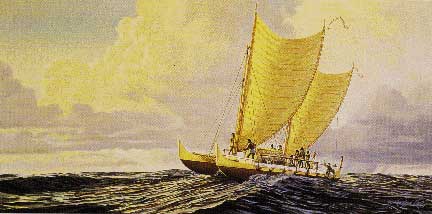|
|
|
|
 |
|
Polynesian explorers, unlike the native plants and animals
that preceded them, achieved landfall through premeditated
voyaging. They sailed against prevailing winds to reach new
lands, carrying with them the food plants they would introduce
to their new homes. The discovery of the Hawaiian Islands
was one of the greatest accomplishments of the Polynesian
navigators, who explored and colonized islands from New Zealand
to Rapa Nui (Easter Island). In this section we will ask when
and how they got here, and where they came from?
|
|
Photo of Mo'olele by Tom Russo
|
|
|
|
|
|
|
|
|
Arrival relies
extensively on Feathered Gods and Fishhooks, by archaeologist
Patrick V. Kirch. In addition, the paintings of Herb Kane give life
to Polynesian voyaging and arrival throughout the Ahupua'a
section. Arrival also excerpts commentary
from Pacific World's beyond excellent web site, Ha'ena, by
RDK Herman |
|
|
Polynesian explorers began their voyages of colonization into
the Pacific over 3000 years ago. Their success depended on three
things:
1) the development of crop plants
2) the refinement of navigational techniques,
3) sophisticated watercraft able to voyage long distances.
(Patrick V. Kirch) |
 |
|
|
Photo of Mo'olele by Brien Foerster
|
|
|
|
|
|
Map from Atlas of Hawai'i
|
|
|
|
|
|
|
The original Polynesian colonists
of Hawai'i came from the Marquesan Islands some time between
350 - 750 A.D. The evidence pointing to the Marquesas as the
original homeland of the first Polynesians to settle Hawai'i
is based on three things:
1) The Hawaiian language is most closely related to Marquesan.
2) An analysis of prehistoric skeletal remains shows a very
close relationship between traits of the Hawaiian and Marquesan
populations.
3) A comparison of DNA in populations of the Pacific Rat, which
was widely spread by the Polynesians, shows a link between the
Hawaiian and Marquesan rat populations.(Patrick V. Kirch) |
|
|
| It is possible that
there was more than one settlement voyage, with multiple voyages
from both the Marquesas and Tahiti. Hawaiian oral traditions
speak of long distance voyages and their famous navigators,
Pa'ao, Mo'i-keha, Kila, and La'a-mai-kahiki.(Kirch) |
 |
|
Hokule'a 1 painting by Herb Kane
|
|
|
 |
The successful expeditions of the modern day double-hulled voyaging
canoe Hokule'a from Aotearoa (New Zealand) to Rapa-Nui (Easter
Island) attest to the sailing and navigational skills that made
Polynesia's explorers the greatest sailors of all time. |
|
|
Navigator painting by Herb Kane |
|
|
|
|
From modern day explorer
Carlos Andrade: "The first people who came, they would
have needed really safe anchorage. Not only in the sense that
it was safe, but it had to be a place where they could sail
into and sail out of, and not be blown up onto the land, Because
they had fairly good size canoes, which you wouldn't be able
to paddle very well, so you had to come into a place where the
direction of the wind allowed you to sail into the beach and
off of the beach really quickly, in case the weather changed."
( from Pacific World's Ha'ena, by RDK Herman)
|
 |
|
Modern day voyaging canoe Hokule'a -
safe anchorage at Nawiliwili Bay.
Photo by Dennis Chun
|
|
|
|
|
|
|
|
|
|
|
|
|
|
Archaeologist Patrick Kirch speaks
about the resources that the Hawaiian settlers encountered:
"To the eyes of the first canoeload of Polynesians who
arrived on a Hawaiian beach, here was a pristine [untouched],
verdant [covered with green vegetation] group of large islands,
with diverse forests made up of strange plants and inhabited
by abundant birds, and with reefs rich in fish and shell fish.
Among the resources critical to the Polynesians were water (both
for consumption and for agriculture), soils, the natural vegetation
(for wood, cords and ropes, thatching materials, and so on),
wild animals and marine life, and stone for tool production."
|
|
|
|
|
|
From Chipper Wichman
- "When the first settlers arrived here, they found incredibly
unique ecosystems, but within those ecosystems there was very
little that could sustain them, other than the marine ecosystem.
The plants they brought with them in their voyaging canoes were
the core of their culture. They were their food plants, their
fiber plants, their medicine plants, their ritual plants. Initially,
they would have looked for a place with abundant marine resources,
fresh water, and rainfall to water the plants that they
had brought with them on their voyages."
(from Pacific World's Ha'ena by RDK Herman) |
|
 |
|
|
Photo by David Boynton
|
|
|
|
|
|
|
|
The ahupua'a of Nawiliwili
Bay offered five streams, large and flat valley bottoms
with fertile soil for agriculture, mature reefs with abundant
marine life, wild animals, natural vegetation, and dike
stone for tool production. Nawiliwili Bay was a safe harbor
with everything the voyagers needed. Once they had arrived,
what kind of changes did these
intrepid (fearless) settlers make in their new island
world? |
|
|
|
|
|
|
|
|
|
|
|
|
Created June 2001
|
|









